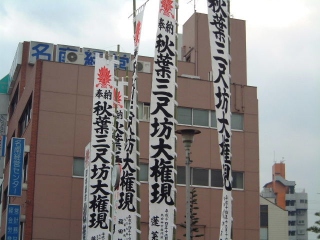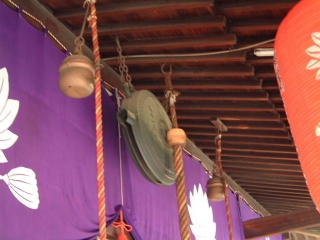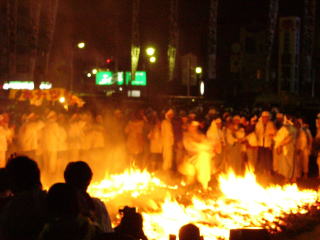 |
Akibasan Entsu-ji
(temple)
Soto School
 |
Entsuji was established by Kobo-daishi/ Kuukai (external link) in the Kojin era (810-824)
and an image of Juuichimen-Kannon (lit. eleven headed Kannon) carved by him was enshrined.
In 1391, Owari family, a kuni-no-miyatsuko (a local officer who concered rituals),
established Jingu-ji (a combined temple of Shinto and Buddhism) and named
it Entsu-ji which belonged Soto School.
When you stand at the gate, the left building is Entsu-ji (temple) and
the right is Akibasan (shrine).
 |
 |
 |
| Samba-seki | Flags of Akibasan-Sanjakubo-Daigongen |
It is said that the gong in the center represents female & the bells, male. This maybe came from folk belief. In the past time, especially poor farmers needed many children as labor forces. |
***
 |
| Hiwatari-shinji. Amazing ! The first shugendo is running on the fire ! |
The most popular shinto ritual of this shrine is "Hiwatari Shinji" which
held on December 16th of each year.
The tutelary deity of Akibasan-Entsu-ji temple, Akibasan Sanjaku-bo Daigongen,
is believed to protect people from fire,
and many Shugendo or mountain priests gathered from all over Japan walk
over smoldering firewood barefoot..
I think this is a must to see.
![]()
Since 1963, Izutsu Stable (Izutsu-beya), one of the Sumo stables,
has been stayed here during Nagoya Tornament (Nagoya Basho) period.
(Maybe from the middle of June to the middle of July)
***
inquiries
Akibasan-Entsu-ji
052-671-6987
address
3-15, Jingu Ni-chome, Atsuta-ku, Nagoya
access
Get off at Tenma-cho sta. on the subway Meijo line.
Take exit 1
map
![]()